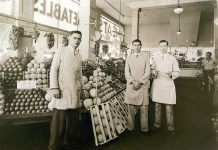Mary Kelley
What is a cynic?
A man who knows the price of everything and the value of
nothing.
— Oscar Wilde
I was sitting next to someone at a meeting recently, and she
turned to me and said, “The Farmers’ Market is too expensive.” It
doesn’t so much make my blood boil as it makes my heart heavy to
hear someone say those words, and I hear them every once in a
while, even this time of year. The heaviness doesn’t last long,
because soon I will hear from another person who is well-informed,
has compared prices, and knows the true value of the locally-grown
produce.
I asked the critic if she could name something at the market
that she considered to be “too expensive.” She said she saw lettuce
priced at $4 per head. Having come from a family that grows
lettuce, and having grown lettuce in my own back yard, I personally
think a lush, fresh, nutritious, large head of organic lettuce is
worth $4. Even at that price the lettuce would be a deal when you
consider the months of preparation that went into that head, the
cost and time taken to select the seed, amend the soil, and prepare
the beds, followed by the planting, cultivating, fertilizing, and
irrigating. Then, the farmer does the harvesting and the trucking
to town, mostly within 10 miles of the Plaza, sets up at the
market, and hopefully, sells the lettuce to a customer. So, after
surviving heat or freeze, slugs and snails, the head of lettuce, as
the base ingredient for a healthful salad for 4 to 6 people, is
worth $4, but I know of no one at the Healdsburg Farmers’ Market
who would sell lettuce at that price.
I asked some of the farmers about their prices. Ed Miller of
Carrot Top Farm replied, “I plan on selling my mid-sized lettuce
for $1.25 this year, after pricing it at $1 for the last 5
years.”
Joel Kiff of Ridgeview Farm wrote, “Price varies on the size of
the head — usually sells for $1.50 and bigger heads for $2. Type
does not affect the price.
Emmett Hopkins of Foggy River Farm explained, “We generally sell
lettuce for $2 an average head, and when we had really giant heads
we sold them for $3 a head, or really small heads for $1. We sold
our 6 ounce baby salad mixes for $3 a bag, which beats Safeway’s
price per ounce of organic baby greens.”
From Mary and Bert Villemaire of La Bonne Terre: “Our regular
lettuces sell for $1.75 and our super large Big Red (Batavian)
lettuce sells for $2 25. We will probably raise our price this year
to $2 for the regular lettuces and $2.50 for the Big Reds.”
The farmers all gave me permission to quote them, and Ed
responded, “Sure, advertise my prices anytime. …I strongly feel
prices should still be prominently posted.” Then I visited our four
local grocery stores and priced organic red leaf lettuce. One store
sold a head for $1.77, another sold at $1.99, and another at $2.19.
One did not have lettuce, but sold salad mix at $8/lb. In this
comparison, there is not a big difference between the price at the
Farmers’ Market and the price at the grocery stores. Some of these
local stores also support local farmers, and I support them in the
winter months. What is important is that more people eat greater
quantities of fresh, local produce; we can all thrive if more
people spend more of their money in the produce aisles as well as
at the Farmers’ Market.
If anyone says the Farmers’ Market is too expensive, please
remind them not to focus on minutiae or they will lose sight of the
big picture. I saw part of this big picture in my first job out of
college, which was in an office above the Oakland Produce Market. I
worked with the produce buyer for the Berkeley Co-op and many other
grocery stores in the east bay, entering data about the item he
purchased, the wholesale price he paid, and the price he charged
the store for his purchase. He also suggested the retail price that
the store would charge to the consumer. I saw the mark-up first
hand. The produce buyer and the store made most of the profit. The
farmer received the smallest portion. This small profit margin
forces farmers to strive for economies of scale, replacing
traditional, sustainable farming practices for conventional,
industrial farming. This is what forces small, traditional farmers
out of business.
When you shop at the Farmers’ Market, you are purchasing produce
directly from the farmer, so there is no middleman. So if you have
a concern for traditional and sustainable farms and farming, and
the socio-economic importance of maintaining small farms and
farming communities, then direct sales at the Farmers’ Market is
one of the best ways to put your dollars and cents directly in the
hands of our local farmers.
Unfortunately, there are so many hidden costs of the free
market, also known as externalities, that it is difficult to keep
track of the true cost of cheap food and the true value of
traditionally grown food. The hidden costs are turning our citizens
into people who are penny wise, and pound foolish; they are careful
when it comes to spending small amounts of money, but careless when
spending much larger amounts. The documentary, Food, Inc., is now
on DVD and it explains many of those hidden costs. Food, Inc. has
been nominated for Best Documentary of the Year, so now is a good
time to share it with a friend; the best we can do is to educate
each other, and make sure our dollars are spent on what we
value.
Mary Kelley is the manager of the Healdsburg Farmers’ Market.
The market is dormant for the winter.








